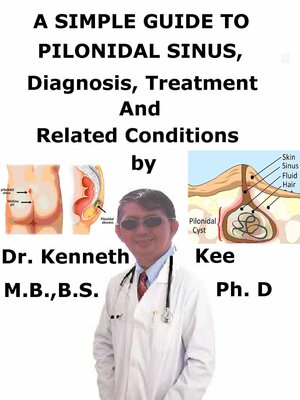
Sign up to save your library
With an OverDrive account, you can save your favorite libraries for at-a-glance information about availability. Find out more about OverDrive accounts.
Find this title in Libby, the library reading app by OverDrive.



Search for a digital library with this title
Title found at these libraries:
| Library Name | Distance |
|---|---|
| Loading... |
This book describes Pilonidal Sinus, Diagnosis and Treatment and Related Diseases
Last month I have a slightly obese young man who is working past-time in the community center teaching old and senior people how to use their mobile phones and studying in the university.
Due to his work and study he had to sit down for long periods.
Because of his prolonged sitting and obesity he developed an infected swelling (abscess possibly developing from a pilonidal sinus) on the right side of the cleft of his buttocks.
He was treated with oral antibiotics and antibiotic cream with improvement but the infection recurred within a few days.
I advised him to consult a surgeon for removal of the suspected pilonidal infected cyst or sinus which may require him to stop working or studying for at least 2 to 3 weeks.
He is reluctant as this will interfere with his work and studies.
Pilonidal sinus, also known as pilonidal cyst, is a disorder characterized by the formation of a small tunnel or cavity in the skin near the tailbone
Pilonidal sinus happens in the area at the top of the buttocks in its cleft and contains dirt and hair; hence the name pilonidal ("pilus" for hair and "nidal" for nest).
Hairs contain bacteria that can produce inflammation and infection.
When pilonidal sinus becomes infected a pilonidal abscess may form and can cause acute pain.
The infected pilonidal sinus is red, painful and may seep out blood and pus with a foul smell
The symptoms of infected pilonidal sinus can develop rapidly, often over a few days.
Pilonidal sinus does not always produce symptoms and only needs treatment if it becomes infected.
Most patients with a pilonidal sinus will not notice it unless it produces symptoms.
It is believed that hair pierces into the subcutaneous tissues through dilated hair follicles which are believed to happen especially in late adolescence (changing hormones and hair growth).
Activities which produce friction, such as sitting for prolonged periods of time or friction from clothes, induces the hair growth in the cleft of the buttocks to dig back beneath the skin.
This embedded hair is regarded as a foreign matter by the body activating an immune response and causing the development of cavity, connected to the surface of the skin by a sinus tract.
This inflammation from the immune response blocks the opening of the follicle which travels inwards, forming a 'pit'
These pits will often passes out serous fluid and can occasionally become acutely infected to form a pilonidal abscess.
Debris or dirt may accumulate in this pit followed by formation of a sinus with a short tract,
Other factors are:
Male
A family history of pilonidal disease
A history of trauma or irritation in the area
Younger persons as pilonidal sinus is more frequent in young adults
Local irritation (buttock friction, increased sweating)
The purpose of non-surgical medical therapy of pilonidal sinus is to remove hair and debris that may cause a chronic inflammatory state that keeps any possible skin tracts open
.
Mild pilonidal sinus improves with washing with mild soap and hair removal.
Pilonidal abscess may be treated with antibiotics and phenol injection
Surgery is the most reliable method to remove the pilonidal sinus and pouches of infection such as:
Incision and drainage
Pit picking
Surgical excision
Wide excision and open healing
Excision and wound closure together
With proper treatment, most cases heal well.
TABLE OF CONTENT
Introduction
Chapter 1 Pilonidal Sinus
Chapter 2...







